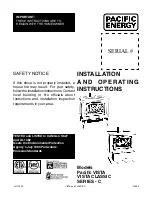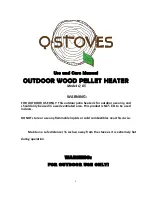
• When placing the stove, a distance of at least 1 meter should be observed at the front. The walls next
to and behind the stove cannot be made of inflammable material. In addition they also cannot be
covered with such materials, unless the distance is more than 30 centimeters on the side and more
than 20 centimeters at the rear.
• A surface underneath the stove made of inflammable material such as wood, cork or carpet needs to
be protected by a floor plate made of nonflammable material such as ceramic, stone, glass or metal.
The floor plate needs to extend 50 centimeters at the front and 30 centimeters at both sides.
3 Use
3.1 Firewood
The incineration system was developed for burning deciduous wood in the form of split logs. It is impor-
tant to burn only purely wind dry wood (moisture level 12 - 15 %). Never use waste, other flammable
materials and / or flammable liquids. This will seriously damage your stove and chimney. Below you will
find the various wood types with their average drying time.
Wood
type
Drying
time
Pine,
Poplar
1
year
Lime, Willow, Spruce, Birch, Ash, Awl
1,5 years
Fruit tree, beech
2 year
Oak 2,5
years
3.2 Ventilation
Incineration requires air. Make sure you have sufficient supply of fresh air. For every kg of wood you
burn (with the device door closed), you need an additional 10 m³ - 15 m³ of air. This means about
an additional 30 m³ per hour. Therefore ample aeration from the outside or through an other room or
hallway is required.
3.3 First time stoking
A new woodstove needs to be put to use gradually. During the first two stokings, you need to limit opera-
tion to a tempered fire. This helps you prevent the following problems:
•
Tearing of the vermiculite;
•
Damaging the coating
•
Deforming the material
•
The rope seals getting stuck.
During the first stokings it is possible that you will notice some pungent odor and smoke. If this happens,
make sure that you properly ventilate the area. During the next stokings, the stove can be used to its full
extent. The ex works soft, scratch sensitive coating has now been completely hardened and burnt in
completely.
3.4 Lighting
When lighting and burning, the stove will be extremely hot and needs at least two hours to cool down
after the fire has been extinguished. Therefore you should not touch the stove without protection when its
burning and two hours after. Always operate the stove using a glove. The lighting process is as follows:
1.
Fully open the air supply.
a Primary aeration; slightly open the ashtray.
b Secondary aeration; push the tube above the door completely into the stove.
c Tertiary aeration; this will automatically be fully opened.
2.
Build an airy stack of wind dry, pure wood with a few clots of paper around it and some kindling.
3.
Light everything.
4.
Leave the door slightly open (3 – 5 min).
5.
When the wood is burning properly, the door can be closed. The fire should now be burning
brightly and intensely.
6.
Let the fire warm up properly and then adjust the incineration control.
6


































